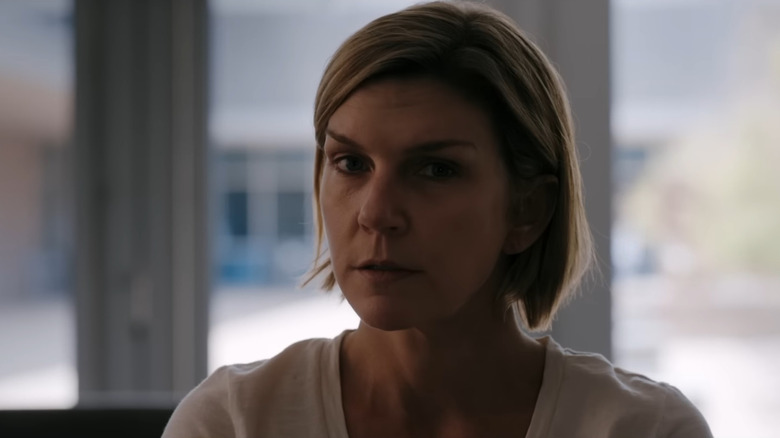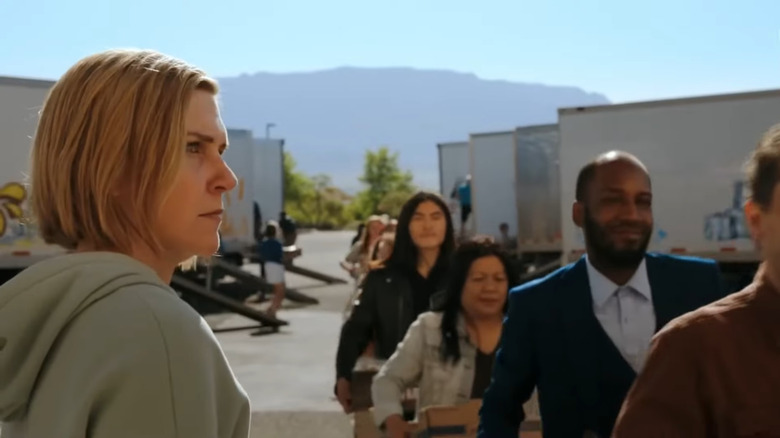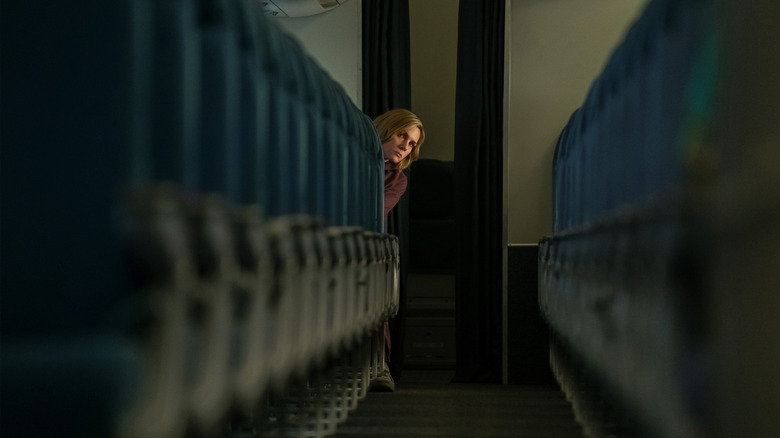Pluribus Episode 3's Secret Weapon Comes Straight From The Breaking Bad Days
Warning: This article contains major spoilers for episode 3 of "Pluribus."
At the risk of hyperbole, can we all agree that the entire medium of television is simply better off when Vince Gilligan is doing his thing? The "Breaking Bad" and "Better Call Saul" creator has made his grand return to the small screen with "Pluribus," the Rhea Seehorn-starring series taking both critics and audiences by storm, and he doesn't appear to have missed a single step. As much as shows like "Succession" or "The White Lotus" or "Severance" have helped usher in the transition from the "Prestige TV" period to a more modern, streaming-focused spin on water-cooler events, there remains something oddly comforting about the vast difference in style and approach here. It's not just the noticeably patient and deliberate storytelling on display, which resulted in throwing some second-screening viewers for a loop. As it turns out, episode 3 of "Pluribus" is a brilliant case study of a particular lost art — and it has its roots in Gilligan's "Breaking Bad" era.
Cast your mind back to the heydays of both "Breaking Bad" and "Better Call Saul." Every episode might as well have been a hands-on lesson straight out of film school, deploying almost every tool in the box to visually convey some of the most nuanced and complex themes on paper. Unusual camera angles, idiosyncratic blocking and staging, and even that memorable shot that sort of made Jimmy McGill look like a blobfish weren't flashy for the sake of it. For the observant viewer, they added yet another subtle layer of meaning to some of the densest and most complex arcs in recent memory. Fortunately for us all, "Pluribus" is taking a page right out of the same playbook.
Pluribus recruits Breaking Bad and Better Call Saul veteran Gordon Smith for its most dazzling-looking episode yet
It doesn't take a liberal arts degree or far too much time spent online internalizing that "One Perfect Shot" method of film analysis to pick up what Vince Gilligan and his creative team are laying down in "Pluribus." The Apple TV series might not look as outwardly gaudy as some of its contemporaries, but don't let that fool you into thinking there's nothing happening underneath the surface. In episodes 1 and 2, Gilligan tackled both writing and directing duties. For this latest hour, however, he handed over the reins to a trusted colleague. As a writers assistant on "Breaking Bad" and eventually a director on "Better Call Saul" (famously taking on the Nacho Vargas-centric season 6 episode "Rock and Hard Place"), Gordon Smith enjoyed the best kind of storytelling crash course there is and put those skills to tremendous use in this week's "Pluribus."
Ostensibly, episode 3 deals with Carol coming to terms with the cheery hive mind and their inability (unwillingness?) to understand what's making her so upset in this dystopian world. But rather than simply spell that out to us in dialogue, Smith and director of photography Paul Donachie (another "Better Call Saul" veteran) went the extra mile to communicate this narrative through the lens. Gilligan fans will likely notice some familiar-looking imagery, such as affixing the camera next to the wheel of a moving car in an early scene when Zosia (Karolina Wydra) drives Carol back from the airport or Carol's warped reflection in a cloche (the fancy name for those dome-shaped serving plates and lids that butlers use) when Zosia delivers some high-end breakfast the next day. Yet it's what comes next that puts "Pluribus" on another level entirely.
Like Breaking Bad and Better Call Saul before it, Pluribus is taking us to (film) school
For a show as existentially terrifying as "Pluribus," there's actually something oddly comforting about how writer/director Gordon Smith takes Vince Gilligan's established visual style and molds it for the purposes of this very different story. There's the haunting — but aesthetically pleasing — precision of how the hive mind accomplishes even the most menial of tasks, like when Carol requests that they restock her favorite grocery store and kicks off the most painstakingly choreographed and synchronized routine you'll ever see. (This also doubles as a fresh take on the most classic of "Breaking Bad"/"Better Call Saul" delights: the extended montage sequence.) Fittingly, however, episode 3 saves its best flourishes for the most small-scale of scenes.
When Zosia pays Carol a visit at her Albuquerque home, dutifully carrying the hand grenade that our protagonist sarcastically demanded, Gordon Smith and Paul Donachie finally begin to pull out all the stops. The first notable moment comes when the camera takes an extreme low-angle point of view, holding both Carol and the grenade in full focus. As film editor, cinematographer, and must-follow social media personality Vashi Nedomansky has previously posted on X, the split diopter shot has been used throughout "Breaking Bad" and "Better Call Saul" to incredibly effect. Here, it draws attention to Chekov's grenade and makes its eventual, ah, impact feel all the more inevitable once it goes off. And when it does, the jarring transition from a Steadicam shot to handheld (complete with pulled frames, another clever choice recently highlighted by Nedomansky) helps highlight the chaos as Carol realizes Zosia may be mortally injured.
🚨 SPLIT DIOPTER ALERT! 🚨
BETTER CALL SAUL – S04 E03
the only 2 split diopter shots
in all 4 seasons of the showFirst: a rare horizontal version
Second: a classic usage...director: Daniel Sackheim
cinematography: Marshall Adams pic.twitter.com/a2CBSQVopP— Vashi Nedomansky, ACE (@vashikoo) October 20, 2019


